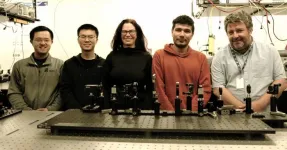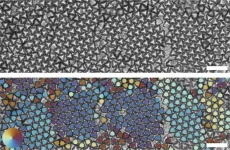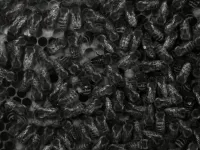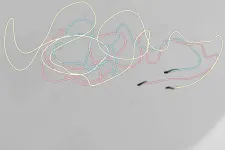(Press-News.org) ITHACA, N.Y. -- By studying individuals who spontaneously clear hepatitis C infections, a team of researchers has identified viable vaccine targets for a disease that infects 70 million worldwide with case numbers increasing every year.
It turns out that a quarter of people who become infected with the hepatitis C virus clear the infection on their own without treatment, while the remaining three-quarters of people develop chronic infections that can last for years. The blood-borne disease – which causes liver cirrhosis, liver failure and liver cancer – is especially prevalent among people who inject drugs.
Direct-acting antivirals developed around a decade ago are 98% effective. But even so, the number of hepatitis C cases has increased year-over-year mainly because early infections are hard to detect, access to treatment is limited and reinfections occur even after treatment.
“That’s why there is now a big interest in developing a hepatitis C vaccine,” said Andrew Flyak, assistant professor of microbiology and immunology in the College of Veterinary Medicine and co-corresponding author of the study, “Convergent Evolution and Targeting of Diverse E2 Epitopes by Human Broadly Neutralizing Antibodies are Associated with HCV Clearance,” which published March 21 in the journal Immunity. Justin Bailey, associate professor of medicine at Johns Hopkins University, is co-corresponding author.
“Our study gives us a glimpse into how certain individuals clear a highly variable infection, and we believe this information can inform a vaccine development,” Flyak said.
The study was made possible due to the unique access that Bailey had to samples from people who injected drugs and were at risk of acquiring the virus. This allowed the researchers to track individuals who were hepatitis C negative when they enrolled in the program, and to see upon subsequent clinic visits whether that person acquired the virus. Bailey obtained samples from individuals who cleared the infection on their own and those who developed chronic infection.
Viruses that evolve very rapidly, such as SARS-CoV-2, influenza and hepatitis C, have extraordinary genetic diversity with multiple strains. Combating these types of infections requires special antibodies (blood proteins that recognize pathogens and neutralize them) called broadly neutralizing antibodies (bNAbs), which can neutralize diverse viral variants.
In previous studies, researchers isolated bNAbs from people who were chronically infected with hepatitis C virus. They found that their bNAbs were using a single antibody gene to encode a variable part of the antibody molecule.
”In order to make an antibody, immune systems use multiple sets of different antibody genes, but for whatever reason the immune systems in people with chronic hepatitis C infections used just one variable antibody gene, called VH1-69,” Flyak said. Also, most of the bNAbs from these chronically infected donors targeted a specific region of the hepatitis C virus, namely the front layer of the so-called E2 protein. The immune system in chronically infected individuals has failed to clear the virus.
In the current study, the researchers isolated bNAbs from one person who spontaneously cleared three separate infections. This individual’s bNAbs revealed important distinctions. First, these bNAbs were genetically diverse, meaning they are encoded by a variety of variable genes, and not just one segment of the VH1-69 gene. Second, bNAbs from this individual targeted three different regions of the virus’ E2 protein, the front layer, as well as a back layer and a b-sandwich.
The data suggests that a hepatitis C virus vaccine should elicit bNAbs to all three regions of the E2 protein rather than just one region of the virus, Flyak said.
“If you have a response to multiple regions, you can have a synergistic effect, you get a response that is much stronger than the sum of its parts,” he said.
BNAbs from the individual who cleared the infections also revealed evidence of what is called convergent evolution, where different bNAbs have the same mutations but come from different antibody variable genes. “You see the same mutations in two different broadly neutralizing antibodies – it means those mutations are important,” Flyak said – and they increase the breadth of the antibody response to hepatitis C virus.
Members of Flyak’s lab used X-ray crystallography to solve the crystal structures of bNAbs in complex with hepatitis C virus’ E2 protein and show how bNAb’s mutations interact with the E2 protein. “That information can be used to design better vaccine candidates,” Flyak said.
In next steps, the team will collaborate with a larger international group to screen multiple vaccine candidates in animals and eventually identify which ones to bring into human clinical trials.
Clinton Ogega, a former graduate student in Bailey’s lab, is the paper’s first author. Two postdoctoral fellows in Flyak’s lab, Marty Schoenle and Xander Wilcox, contributed to the study.
The study was supported by the National Institutes of Health.
-30-
END
Insights from patient who cleared hepatitis C could lead to vaccine
2024-03-25
ELSE PRESS RELEASES FROM THIS DATE:
Uncovering the mystery of Dorset’s Cerne Giant
2024-03-25
For centuries, the Cerne Giant, a figure carved into a hillside in Dorset depicting a nude man carrying a club and stretching some 180 feet high, has fascinated locals and visitors to the area. The history of the giant, however, and in particular, its age, has long been a mystery. A new paper in Speculum: A Journal of Medieval Studies proposes that the Cerne Giant can in fact be dated to the early Middle Ages, and, as a result, its cultural context and significance more clearly understood.
“The Cerne Giant in its Early Medieval Context,” by authors Thomas Morcom and Helen Gittos, acknowledges that previous attempts to date the giant placed ...
RCSI research identifies promising drug combination for multiple myeloma treatment
2024-03-25
25 March 2024: RCSI research has found that venetoclax, a medication currently approved for leukaemia, has benefits for patients with multiple myeloma when used in combination with another drug. This discovery offers a new avenue of treatment options for the currently incurable disease.
Multiple myeloma (MM) is a type of blood cancer that is newly diagnosed in around 400 people in Ireland each year. Despite treatment advances in recent years, it remains incurable. The search for innovative treatment strategies is crucial, particularly for patients whose cancer is resistant to standard care.
In the new study published in Haematologica, researchers at the RCSI Department of ...
Confusing assistance requirements contribute to food insecurity among college students
2024-03-25
Philadelphia, March 25, 2024 – Food insecurity among college students is associated with negative physical and mental health and lower academic performance and graduation rates. A recent research study in the Journal of Nutrition Education and Behavior, published by Elsevier, investigates why over half of college students eligible for the Supplemental Nutrition Assistance Program (SNAP)—the nation’s largest food assistance program—do not apply.
Lead study author Suzanna M. Martinez, PhD, MS, Department of Epidemiology and Biostatistics, University of California San Francisco, explained, “In California, ...
Pushing back the limits of optical imaging by processing trillions of frames per second
2024-03-25
Professor Jinyang Liang’s team is advancing in imaging speed with a new ultrafast camera system.
Pushing for a higher speed isn’t just for athletes. Researchers, too, can achieve such feats with their discoveries. This is the case for Jinyang Liang, Professor at the Institut national de la recherche scientifique (INRS), and his team, whose research results have recently been published in Nature Communications.
The group based at INRS’ Énergie Matériaux Télécommunications Research Centre has developed a new ultrafast camera system that can capture up to 156.3 trillion ...
Patient recovery after surgery for esophageal cancer isn’t influenced by using standard or keyhole incisions
2024-03-25
New research has found no evidence of a difference between recovery time and complications when comparing standard and keyhole surgical incisions for the treatment of oesophageal cancer (cancer of the gullet). The study, led by the University of Bristol Medical School and published in the British Journal of Surgery, showed surgeons treating patients with oesophageal cancer do not need to change their practice if they have a strong preference for either procedure type.
Oesophageal cancer is the tenth most common cancer globally. It causes one in 18 cancer-related deaths. ...
COVID-19 pandemic has left an enduring imprint on colorectal cancer surgery
2024-03-25
Key Takeaways
In a retrospective analysis of 105,517 patients with colorectal cancer, researchers found that colorectal cancer surgical cases fell by 17.3% during the first year of the pandemic.
Patients who underwent surgery for colorectal cancer in 2020 displayed more advanced stages of cancer compared to those treated in 2019.
The authors attribute these findings to multiple factors, including delays in screening, fear of COVID-19 exposure that may have prevented some people from seeking care, and disparities in cancer care that were likely exacerbated during the pandemic.
CHICAGO: While the COVID-19 pandemic is no longer considered a public ...
Elusive 3D printed nanoparticles could lead to new shapeshifting materials
2024-03-25
In nanomaterials, shape is destiny. That is, the geometry of the particle in the material defines the physical characteristics of the resulting material.
“A crystal made of nano-ball bearings will arrange themselves differently than a crystal made of nano-dice and these arrangements will produce very different physical properties,” said Wendy Gu, an assistant professor of mechanical engineering at Stanford University, introducing her latest paper which appears in the journal Nature Communications. “We’ve used a 3D nanoprinting technique to produce one of the most promising ...
Bees use antennae to decode hive mates’ dances in the dark
2024-03-25
Scientists have discovered how honeybees can decipher dances by their hive mates that relay directions to food.
The findings reveal how, in the complete darkness of the hive, each bee uses its antennae to help interpret the information communicated through the dances.
It has been known for decades that honeybees do so-called waggle dances, in which their movements and orientation on the honeycomb signal the direction and distance to food outside the hive. However, until now, it was unclear how the bees gathered around a waggle dancer make sense of the information.
Gaining greater insights into how bees communicate could help scientists to better understand the effects of ...
Nucleus Genomics launches to bring whole-genome sequencing to the public
2024-03-25
Nucleus Genomics, the next-generation genetic testing and analysis company, today announced the launch of its DNA analysis product to bring the benefits of personalized medicine to everyone.
DNA and health are inextricably linked, but profound insights into how DNA can shape health are missing from healthcare. Customers who’ve previously done microarray genetic testing with older testing companies can upload their DNA data onto Nucleus’ platform to receive greater insights into their genetic risk for diseases like type 2 diabetes, breast cancer, and many more. Nucleus further personalizes these risk assessments by integrating personal ...
How many fish constitute a school?
2024-03-25
Physicists are also interested in fish – above all when they are researching the formation of structures. A research team from Heinrich Heine University Düsseldorf (HHU) and the University of Bristol (United Kingdom) has examined the schooling behaviour of zebra danio (Danio rerio, also known as “zebrafish”) using methods from the field of multi-particle physics. In the scientific journal Nature Communications, they explain that groups of just three fish already move in a similar way to large schools while, by contrast, two fish display completely ...





